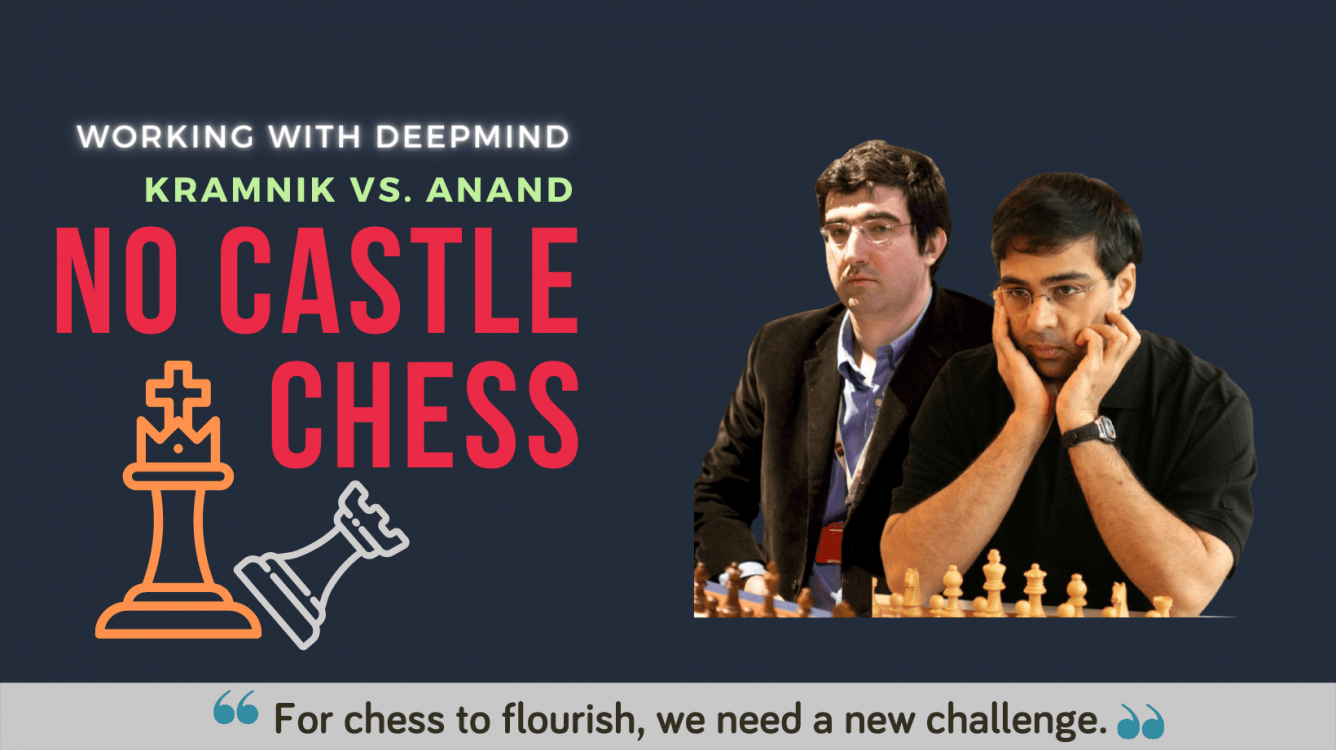
A brief history of No Castle Chess
No castle chess is the new sensation in the chess world. Currently, at Dortmund, Vishy Anand and Vladimir Kramnik are playing four-match games of which Anand won the first one and drew the second game!
History of No Castle Chess:
No Castle Chess has a very thought-provoking history. The variation was first proposed by former world champion Vladimir Kramnik. In his words,
For chess to flourish, we need a new challenge.
The increasing strength of chess engines, the millions of computer games and the volumes of opening theory available to every player are making top-level chess less imaginative. Decisive games in super-tournaments have declined, while the number of games with what I'd call "creative" content is also on the slide.
In terms of decisive games, we all saw Carlsen and Caruana drew all their classical games. Only later in the fewer time control games, Carlsen was able to pull a win. In this regard, Kramnik also wrote,
This is not the players’ fault, but the reality they face. It would be strange to expect them to deliberately decrease their chances of a positive outcome by taking unreasonable risks for the sake of playing more “entertaining” games. From my own experience, I know how difficult it has become to force a complex and interesting fight if your opponent wants to play it safe. As soon as one side chooses a relatively sterile line of play, the opponent is forced to follow suit, leading to an unoriginal game and an inevitably drawish outcome.
Of course, there are still some fascinating top-level games being played, but to keep chess alive, I believe we must reverse this trend before the game’s spirit fades away.
Kramnik wanted to take an initiative. For his theory to prove, he needed expert technological help. How he started working with DeepMind- in his words:
So I started thinking, if the outcome is always the same, perhaps there’s something we can do to reinvigorate the game. I spoke with Demis Hassabis, the founder and CEO of the artificial intelligence lab DeepMind. Hassabis was once one of the strongest junior chess players in the United Kingdom and is still a devoted chess aficionado. I was granted an opportunity to test my theory with the famous machine-learning chess engine AlphaZero.
Working with DeepMind researchers Ulrich Paquet and Nenad Tomasev, we used AlphaZero as a petri dish to test different variations and see how the game might unfold. Ultimately, our mission was to find an adjustment to the rules to allow more space for human creativity.
His aim was to find a chess variant that would not only have the potential to bring excitement and decisive victories back to chess but is also aesthetically pleasing. The goal was to reignite interest and introduce players and audiences to the immense complexity and creativity of the original game of chess. (Kramnik)
No Castle Games in history:
Castling in chess games is somewhat an essential part. It’s done for mostly king’s safety, gaining advantages, tempo, fast attacks, and surprisingly- it often leads to checkmate!
One of the popular examples of the 'castle and mate' probably this:
It’s not like that the king will be super safe if it goes to the corner of the board. Attacks can always raise its storm anywhere. If the pieces are placed right, a castle will not help to prevent checkmate. For example, Greek Gift Sacrifice!
You have castled thinking of the safety issue but forgot to look at the piece’s placement. After some time, your opponent sacrificed his bishop. You either end up losing your Queen or the game. You can also sacrifice your queen to continue a bit longer, but you know- it’s never going to work anyway.
Finding the age of ‘No Castle Chess’ is a mammoth task, or is it? The oldest game I have found so far is between Capablanca and Alfred Schroeder, played in Rice Memorial on January 19, 1916. The game lasted 30 moves and Capablanca didn’t castle.
In Vienna on November 4, 1922, Alexander Alekhin displayed a dazzling light over the board against Hans Komch with black pieces. He didn’t become the champion of the event though; rather it was Akiba Rubinstein who managed to win the event with 11.5 points out of 14 and no losses!
Rubinstein played another game a year afterward, in Maehrisch-Ostrau Tournament, 1923. 14 players participated in the event; The games were played between 1-18 July. The former world champion Emanuel Lasker participated too. It was indeed a great event for Lasker as he became the unbeaten champion of the event.
In the event, Akiba Rubinstein played with white pieces against Karel Hromadka. This game lasted 29 moves, and with no castle- Akiba won a grandiloquent game!
In Prague Olympiad, 1931, the great Indian chess player Mir Sultan Khan defeated Hermais Mattison, and guess what? The game lasted for 22 moves. Sultan drove a strong attack towards the King-Side-Castled King. Mattison couldn’t be able to run away and thus gave up.
The games I used here as examples have fewer moves in comparison with modern times. What will be the stable future of chess? Is there any at all? With the drastic rise of the chess engines, many possibilities are being created every day.
The answer is somewhere in the wind, and the possibilities are there too. We just have to go with the wind!
Read Kramnik's article here.
